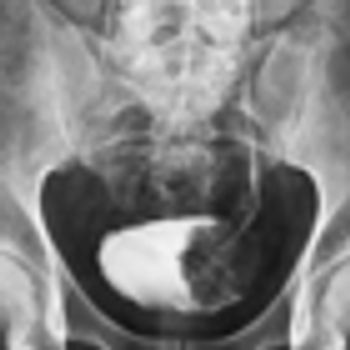
General practitioners took longer to suspect a diagnosis of bladder or renal cancer in women compared with men, according to a recent study.

Your AI-Trained Oncology Knowledge Connection!


General practitioners took longer to suspect a diagnosis of bladder or renal cancer in women compared with men, according to a recent study.

Recent studies suggest patients with bladder cancer are not receiving optimal care or the follow-up surveillance as recommended by the National Comprehensive Cancer Network (NCCN).

The use of cannabis among men has been linked to a significantly decreased risk for bladder cancer, according to a recent study; however, no cause and effect association has been found.

This review focuses on targeted therapies related to these pathways of interest for the treatment of advanced urothelial carcinoma, describing the evidence to support further investigation of these approaches.

Current efforts utilizing genomic strategies to unravel the biology of urothelial carcinoma will undoubtedly lead to rational targets, new therapies, and a renewed enthusiasm among researchers and clinicians working in this field-which ultimately will improve the lives of patients with this devastating disease.

Advanced urothelial cancer remains, along with pancreatic cancer, one of the last solid tumors for which essentially no progress has been made for 25 years. It’s time to think out of the box, and to develop novel and creative ways of overcoming the real, but not insurmountable, logistical challenges to carrying out the needed clinical trials.

In a trial of 64 patients, neoadjuvant chemotherapy with methotrexate, doxorubicin, vinblastine, and cisplatin (MVAC) had promising results in the treatment of muscle-invasive bladder cancer.

The use of presurgical characteristics to assign the clinical stage of a patient with bladder cancer was found to be highly inaccurate with a clinical/pathological stage discrepancy rate of 47.8% found in a large sample of patients taken from the National Cancer Data Base between 1998 and 2009.

Researchers have identified bladder cancer markers that can predict which patients may have the most aggressive, fatal type of the disease. It was also discovered that smoking can affect the course of bladder cancer development, leading to more aggressive forms of the disease.

In a multicenter phase III trial of 360 patients with muscle-invasive bladder cancer, synchronous chemoradiotherapy provided better locoregional control without significant added toxicity, investigators for the Bladder Cancer 2001 trial have found.

The antiangiogenic agent pazopanib demonstrated clinically meaningful activity in patients with refractory urothelial cancer in a phase II proof-of-concept study, identifying pazopanib as the first targeted compound to have clinically meaningful activity in patients with refractory urothelial cancer.

Muscle-invasive bladder cancer is an aggressive and potentially lethal disease. Integration of multimodal therapies, improved surgical techniques, and utilization of targeted agents has tremendously improved outcomes.

Patient selection based on a much more comprehensive biologic assessment of both host and tumor is likely the key to further advances in the treatment of all bladder cancer patients. Until such time, there can be no compromise in the careful application of the rigorous therapy required to optimize outcomes.

Still missing in our treatment of bladder cancer are the tools to accurately predict response to a specific therapy, whether it be chemotherapy, radiation, or transurethral resection alone. Once we have these tools, we will be well on our way to applying a more intelligent, true personalized medicine approach to the treatment of this disease.

Wide variations in the care of early bladder cancer exist, and among high–treatment intensity urology providers, overall survival is unchanged while rates of transition to major surgery are actually increasing. It has been said that for bladder tumors, it is time for a paradigm shift. We believe that the time is overdue.

Bladder cancer is a complex neoplasm with multiple histologic subtypes and a wide spectrum of clinical states, ranging from relatively nonlethal Ta cancers to virulent M1 disease.

In this issue of ONCOLOGY, Kamat and Mathew provide an excellent overview of the current status and future imperatives of bladder cancer treatment and research.

Dapagliflozin, the experimental diabetes medication being developed by Bristol-Myers Squibb and AstraZeneca was found to raise the risk of both bladder and breast cancers. The data were presented at the American Diabetes Association Meeting in San Diego, Calif. at the end of June.

Adding chemotherapy to radiation therapy for muscle invasive bladder cancer may allow up to 67% of patients to be free of disease two years post-treatment, according to a study out of the UK. In addition, this treatment combination may offer a significant number of patients a better quality of life by avoiding surgery.

The review by Rampersaud and colleagues provides an excellent summary of the scientific rationale for using hyperthermia to treat cancer and of the current status of combinations of hyperthermia and chemotherapy or radiotherapy. In view of the demonstrated efficacy of the combination of intravescial hyperthermia and mitomycin C (MMC) therapy in preventing the progression and recurrence of non–muscle-invading bladder cancer (NMIBC) in several clinical trials, Rampersaud and colleagues advocate additional studies to further optimize the delivery of hyperthermia and to delineate its clinical utility in this disease.

Modern cancer care is characterized by a focus on organ-sparing multi-modal treatments. In the case of non–muscle-invasive bladder cancer this is particularly true; treatment is focused on reducing the frequency of low-risk recurrences and preventing high-risk progression. Deep regional hyperthermia is an oncologic therapeutic modality that can help achieve these two goals. The combination of hyperthermia with chemotherapy and radiotherapy has improved patient outcomes in several tumor types. In this review, we highlight the biology of therapeutic fever-range hyperthermia, discuss how hyperthermia is administered and dosed, demonstrate how heat can be added to other treatment regimens, and summarize the data supporting the role of hyperthermia in the management of bladder cancer.

Bladder cancer is the fourth most common cancer (excluding skin cancer) in the United States and ranks eighth as a cause of death from cancer among men; there will be an estimated 70,530 new cases and 14,680 cancer-related deaths in the United States in 2010.[1] Of new cases, 70% to 80% present with non–muscle-invasive bladder cancer (NMIBC). Despite endoscopic and intravesical treatments with curative intent, 50% to 70% of these cancers recur, usually within 5 years, and 10% to 30% progress to muscle-invasive disease, in the majority of cases as high-grade lesions.[2,3] Bladder cancer poses a significant economic burden due to the cost of the lifetime need for surveillance, the need to treat recurrent tumors, and the cost of complications associated with treatment. Medicare estimates have ranked bladder cancer treatment the seventh costliest among cancers, with a 5-year net cost of approximately one billion dollars.[4]

Extramedullary disease in plasma cell disorders can occur as a solitary plasmacytoma or can involve multiple sites with vastly different clinical outcomes. The article by Khaliq et al reports an unusual case of solitary extramedullary plasmacytoma (SEP) of the bladder in which the patient had a favorable outcome with lenalidomide/dexamethasone after failing first-line treatment with radiotherapy. In this context it is interesting to compare clinical outcomes of this entity to two other clinical variants of myeloma: solitary plasmacytoma of bone (SPB), and multiple myeloma with extramedullary plasmacytomas (MM/EP).

Plasmacytoma is a rare B-lymphocyte neoplastic disorder that usually presents as the generalized disease multiple myeloma. Less than 5% of the cases present as a solitary mass of monoclonal plasma cells in the bone or soft tissue. Although solitary extramedullary plasmacytoma (SEP) may arise in any organ, it rarely involves the urinary bladder. A 67-year-old male without a history of multiple myeloma presented with urinary frequency and nocturia; he was later diagnosed with SEP of the bladder. The patient was initially treated with a course of radiation therapy without symptomatic improvement; therefore a chemotherapy regimen consisting of lenalidomide and dexamethasone was subsequently given for six cycles. SEP usually carries a better prognosis and higher cure rate than solitary plasmacytoma of bone, as SEP is radiation sensitive. The role of adjuvant chemotherapy in the treatment of SEP that is resistant to radiation therapy is not clear, since most of the recommendations have been derived from the experience of head and neck SEP. The literature also lacks recommendations for choice of a chemotherapy regimen and surveillance of isolated bladder plasmacytoma. Here we present the first case of a radiation-resistant solitary plasmacytoma of the bladder that was successfully treated with lenalidomide and dexamethasone with successful clinical remission.

The authors on “Solitary Extramedullary Plasmacytoma of the Bladder” have provided a quick and accurate diagnosis, work-up, and treatment of this solitary extramedullary plasmacytoma. Solitary extramedullary plamacytomas are rare, and account for only 3% of all plasma cell malignancies. Of the 3% of plasma cell malignancies that are diagnosed, the bladder is one of the least common locations. The rarity of the tumor frequently makes the process of making a correct diagnosis difficult.[1] After making the diagnosis with immunohistochemistry, a bone marrow biopsy must be performed to rule out multiple myeloma. Additionally, a body and skeletal survey must show no evidence of additional disease or lytic lesions in order to confirm localized disease. In this case, these procedures were performed accurately and in a timely fashion.